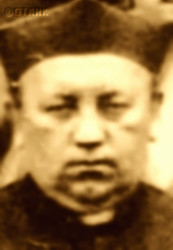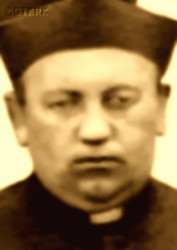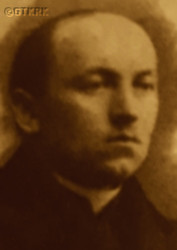Roman Catholic
St Sigismund parish
05-507 Słomczyn
85 Wiślana Str.
Konstancin deanery
Warsaw archdiocese, Poland
full list:
displayClick to display full list

searchClick to search full list by categories
wyświetlKliknij by wyświetlić pełną listę po polsku

szukajKliknij by przeszukać listę wg kategorii po polsku

Martyrology of the clergy — Poland
XX century (1914 – 1989)
personal data
surname
BULOWSKI
surname
versions/aliases
BUŁOWSKI
forename(s)
Michael Francis (pl. Michał Franciszek)

function
religious cleric
creed
Latin (Roman Catholic) Church RCmore on
en.wikipedia.org
[access: 2014.09.21]
congregation
Society of St Francis de Sales SDBmore on
en.wikipedia.org
[access: 2013.05.19]
(i.e. Salesians of Don Bosco)
diocese / province
St Stanislav Kostka Warsaw Inspectorate SDB
apostolic administration in Drohiczyn (Pinsk diocese)more on
en.wikipedia.org
[access: 2013.05.19]
Pinsk diocesemore on
en.wikipedia.org
[access: 2013.05.19]
date and place
of death
30.09.1956

Nur‐Sułtanform.: Akmolinsk
today: Akmola reg., Kazakhstan
more on
en.wikipedia.org
[access: 2023.07.16]
alt. dates and places
of death
1956, 09.1956
Moscowtoday: Moscow city, Russia
more on
en.wikipedia.org
[access: 2020.07.31]
details of death
After German and Russian invasion of Poland in 09.1939 and start of the World War II, after start of Russian occupation, remained in Reginów despite closure of Silesians Institute.
Was there after German attack on 06.1941 of their erstwhile ally, Russians, and start of German occupation — lived in the vicinity of the former Silesian's oratory in Reginów appropriated by the occupants, staying privately in local parishioners houses.
In 1944, after German defeat and start of another Russian occupation, remained in former Poland then occupied by Russia.
Seriously sick prob. dragged out of his rectory in Rubieżewicze by his matron and taken to Kazakhstan, possibly for financial gain.
There left out and perished.
alt. details of death
According to other sources died on a train while being dragged to Moscow, or in Moscow itself.
cause of death
extermination
perpetrators
Russians
sites and events
GulagClick to display the description, Ribbentrop‐MolotovClick to display the description, Pius XI's encyclicalsClick to display the description
date and place
of birth
03.09.1891

Chwałowicetoday: Radomyśl nad Sanem gm., Stalowa Wola pov., Subcarpathia voiv., Poland
more on
en.wikipedia.org
[access: 2021.12.18]
religious vows
22.08.1914 (last)
presbyter (holy orders)
ordination
22.12.1918

Gualdo Tadinotoday: Perugia prov., Umbria reg., Italy
more on
en.wikipedia.org
[access: 2023.07.16]
positions held
1952 – 1956
priest — Rubezhevichitoday: Rubezhevichi ssov., Stowbtsy dist., Minsk reg., Belarus
more on
be.wikipedia.org
[access: 2022.09.11] ⋄ St Joseph RC parish ⋄ Stowbtsytoday: Stowbtsy dist., Minsk reg., Belarus
more on
en.wikipedia.org
[access: 2022.12.25] RC deanery
priest — Lesnayatoday: Lesnaya ssov., Baranavichy dist., Brest reg., Belarus
more on
uk.wikipedia.org
[access: 2022.08.05] ⋄ Our Lady of the Angels RC parish ⋄ Baranavichytoday: Baranavichy dist., Brest reg., Belarus
more on
en.wikipedia.org
[access: 2022.05.02] RC deanery
1936 – 1944
friar — Reginówvillage
today: non‐existent, Volka ssov., Ivatsevichy dist., Brest reg., Belarus
more on
pl.wikipedia.org
[access: 2022.09.11] ⋄ Society's House, Salesians of Don Bosco SDB — chapel chaplain and confessor
1930 – 1936
superior — Płocktoday: Płock city pov., Masovia voiv., Poland
more on
en.wikipedia.org
[access: 2021.12.18] ⋄ „Stanisławówka” Educational Institute, Society's House, Salesians of Don Bosco SDB
1927 – 1930
superior — Ciechanówtoday: Ciechanów urban gm., Ciechanów pov., Masovia voiv., Poland
more on
en.wikipedia.org
[access: 2021.12.18] ⋄ Society's House, Salesians of Don Bosco SDB
1925 – 1927
friar — Vilniustoday: Vilnius city dist., Vilnius Cou., Lithuania
more on
en.wikipedia.org
[access: 2022.01.06] ⋄ Society's House, Salesians of Don Bosco SDB — director of Educational Institute
1924 – 1925
superior — PrzemyślZasanie district
today: Przemyśl city pov., Subcarpathia voiv., Poland
more on
en.wikipedia.org
[access: 2021.04.01] ⋄ Society's House, Salesians of Don Bosco SDB — also: parish priest of St Joseph parish
1923 – 1924
friar — KrakówDębniki district
today: Kraków city pov., Lesser Poland voiv., Poland
more on
en.wikipedia.org
[access: 2021.12.18] ⋄ Blessed Virgin Mary Immaculate Conception Society's Houses, Salesians of Don Bosco SDB — administrator of the Educational Institute
1920 – 1923
friar — KrakówDębniki district
today: Kraków city pov., Lesser Poland voiv., Poland
more on
en.wikipedia.org
[access: 2021.12.18] ⋄ Blessed Virgin Mary Immaculate Conception Society's Houses, Salesians of Don Bosco SDB — employee of the Educational Institute
1920 – 1924
friar — KrakówDębniki district
today: Kraków city pov., Lesser Poland voiv., Poland
more on
en.wikipedia.org
[access: 2021.12.18] ⋄ Blessed Virgin Mary Immaculate Conception Society's Houses, Salesians of Don Bosco SDB — parish minister
till 1918
student — (Italy territory)today: Italy
more on
en.wikipedia.org
[access: 2021.12.18] ⋄ Theological Institute (higher theological seminary), Salesians of Don Bosco SDB
from 1914
student — (Italy territory)today: Italy
more on
en.wikipedia.org
[access: 2021.12.18] ⋄ Philosophical Institute (also known as the Philosophical Studentate), Salesians of Don Bosco SDB
1910 – 1911
novitiate — Radnatoday: Sevnica gm., Lower Sava reg., Slovenia
more on
en.wikipedia.org
[access: 2022.09.11] ⋄ Society's House, Salesians of Don Bosco SDB
1905 – 1910
pupil — Oświęcimtoday: Oświęcim gm., Oświęcim pov., Lesser Poland voiv., Poland
more on
en.wikipedia.org
[access: 2021.06.07] ⋄ Philosophical Institute (also known as the Philosophical Studentate), Salesians of Don Bosco SDB
sites and events
descriptions
Gulag: The acronym Gulag comes from the Rus. Главное управление исправительно‐трудовых лагерей и колоний (Eng. Main Board of Correctional Labor Camps). The network of Russian concentration camps for slave labor was formally established by the decision of the highest Russian authorities on 27.06.1929. Control was taken over by the OGPU, the predecessor of the genocidal NKVD (from 1934) and the MGB (from 1946). Individual gulags (camps) were often established in remote, sparsely populated areas, where industrial or transport facilities important for the Russian state were built. They were modeled on the first „great construction of communism”, the White Sea‐Baltic Canal (1931‐1932), and Naftali Frenkel, of Jewish origin, is considered the creator of the system of using forced slave labor within the Gulag. He went down in history as the author of the principle „We have to squeeze everything out of the prisoner in the first three months — then nothing is there for us”. He was to be the creator, according to Alexander Solzhenitsyn, of the so‐called „Boiler system”, i.e. the dependence of food rations on working out a certain percentage of the norm. The term ZEK — prisoner — i.e. Rus. заключенный‐каналоармец (Eng. canal soldier) — was coined in the ITL BelBaltLag managed by him, and was adopted to mean a prisoner in Russian slave labor camps. Up to 12 mln prisoners were held in Gulag camps at one time, i.e. c. 5% of Russia's population. In his book „The Gulag Archipelago”, Solzhenitsyn estimated that c. 60 mln people were killed in the Gulag until 1956. Formally dissolved on 20.01.1960. (more on: en.wikipedia.orgClick to attempt to display webpage
[access: 2024.04.08])
Ribbentrop‐Molotov: Genocidal Russian‐German alliance pact between Russian leader Joseph Stalin and German leader Adolf Hitler signed on 23.08.1939 in Moscow by respective foreign ministers, Mr. Vyacheslav Molotov for Russia and Joachim von Ribbentrop for Germany. The pact sanctioned and was the direct cause of joint Russian and German invasion of Poland and the outbreak of the World War II in 09.1939. In a political sense, the pact was an attempt to restore the status quo ante before 1914, with one exception, namely the „commercial” exchange of the so‐called „Kingdom of Poland”, which in 1914 was part of the Russian Empire, fore Eastern Galicia (today's western Ukraine), in 1914 belonging to the Austro‐Hungarian Empire. Galicia, including Lviv, was to be taken over by the Russians, the „Kingdom of Poland” — under the name of the General Governorate — Germany. The resultant „war was one of the greatest calamities and dramas of humanity in history, for two atheistic and anti‐Christian ideologies — national and international socialism — rejected God and His fifth Decalogue commandment: Thou shall not kill!” (Abp Stanislav Gądecki, 01.09.2019). The decisions taken — backed up by the betrayal of the formal allies of Poland, France and Germany, which on 12.09.1939, at a joint conference in Abbeville, decided not to provide aid to attacked Poland and not to take military action against Germany (a clear breach of treaty obligations with Poland) — were on 28.09.1939 slightly altered and made more precise when a treaty on „German‐Russian boundaries and friendship” was agreed by the same murderous signatories. One of its findings was establishment of spheres of influence in Central and Eastern Europe and in consequence IV partition of Poland. In one of its secret annexes agreed, that: „the Signatories will not tolerate on its respective territories any Polish propaganda that affects the territory of the other Side. On their respective territories they will suppress all such propaganda and inform each other of the measures taken to accomplish it”. The agreements resulted in a series of meeting between two genocidal organization representing both sides — German Gestapo and Russian NKVD when coordination of efforts to exterminate Polish intelligentsia and Polish leading classes (in Germany called «Intelligenzaktion», in Russia took the form of Katyń massacres) where discussed. Resulted in deaths of hundreds of thousands of Polish intelligentsia, including thousands of priests presented here, and tens of millions of ordinary people,. The results of this Russian‐German pact lasted till 1989 and are still in evidence even today. (more on: en.wikipedia.orgClick to attempt to display webpage
[access: 2015.09.30])
Pius XI's encyclicals: Facing the creation of two totalitarian systems in Europe, which seemed to compete with each other, though there were more similarities than contradictions between them, Pope Pius XI issued in 03.1937 (within 5 days) two encyclicals. In the „Mit brennender Sorge” (Eng. „With Burning Concern”) published on 14.03.1938, condemned the national socialism prevailing in Germany. The Pope wrote: „Whoever, following the old Germanic‐pre‐Christian beliefs, puts various impersonal fate in the place of a personal God, denies the wisdom of God and Providence […], whoever exalts earthly values: race or nation, or state, or state system, representatives of state power or other fundamental values of human society, […] and makes them the highest standard of all values, including religious ones, and idolizes them, this one […] is far from true faith in God and from a worldview corresponding to such faith”. On 19.03.1937, published „Divini Redemptoris” (Eng. „Divine Redeemer”), in which criticized Russian communism, dialectical materialism and the class struggle theory. The Pope wrote: „Communism deprives man of freedom, and therefore the spiritual basis of all life norms. It deprives the human person of all his dignity and any moral support with which he could resist the onslaught of blind passions […] This is the new gospel that Bolshevik and godless communism preaches as a message of salvation and redemption of humanity”… Pius XI demanded that the established human law be subjected to the natural law of God , recommended the implementation of the ideal of a Christian state and society, and called on Catholics to resist. Two years later, National Socialist Germany and Communist Russia came together and started World War II. (more on: www.vatican.vaClick to attempt to display webpage
[access: 2023.05.28], www.vatican.vaClick to attempt to display webpage
[access: 2023.05.28])
sources
personal:
bws.sdb.org.plClick to attempt to display webpage
[access: 2019.05.30]
bibliographical:
„Prisoners free at last”, Waldemar W. Żurek, SDB
original images:
www.stanislawowka.plClick to attempt to display webpage
[access: 2018.02.15], galeria.plock24.plClick to attempt to display webpage
[access: 2018.02.15]
LETTER to CUSTODIAN/ADMINISTRATOR
If you have an Email client on your communicator/computer — such as Mozilla Thunderbird, Windows Mail or Microsoft Outlook, described at WikipediaPatrz:
en.wikipedia.org, among others — try the link below, please:
LETTER to CUSTODIAN/ADMINISTRATORClick and try to call your own Email client
If however you do not run such a client or the above link is not active please send an email to the Custodian/Administrator using your account — in your customary email/correspondence engine — at the following address:

giving the following as the subject:
MARTYROLOGY: BULOWSKI Michael Francis
To return to the biography press below:
 Click to return to biography
Click to return to biography










